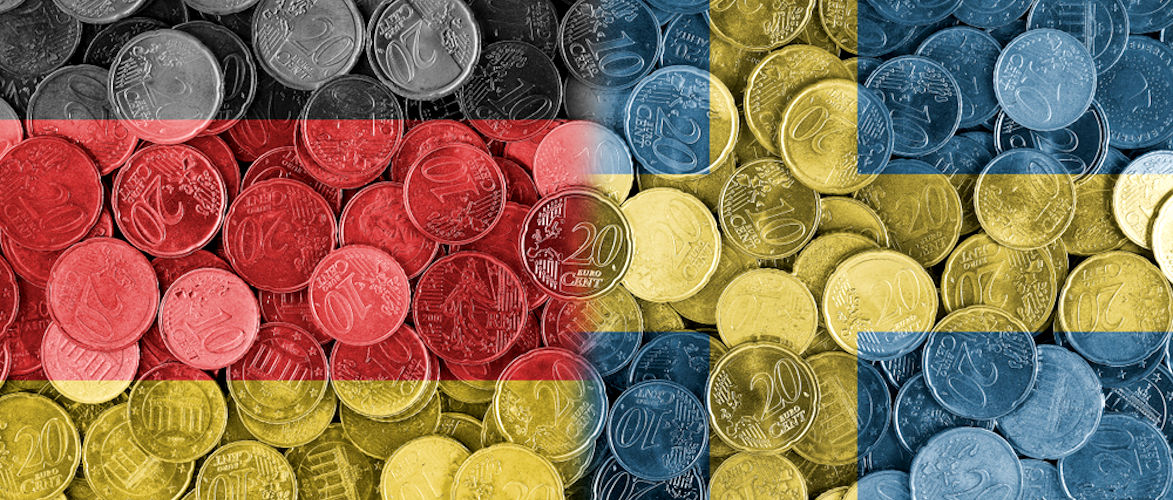How the corona lockdowns lead us into the worst recession of modern times
By Christian Kreiß.
In the last few days the latest figures on economic development in the US and Europe have been published. The International Monetary Fund speaks of one “Crisis like never before” and the Institute for International Finance titled a study “Covid-19 lights the fuse”.
The US economy shrank in the second quarter (April to June) 2020 by 9.5 percent compared to the previous year. That was “the greatest contraction that ever was”. Europe was hit even worse. The euro zone shrank by 15 percent in the second quarter of 2020 compared to the second quarter of 2019. That means: more than a seventh of economic output has simply disappeared. Every seventh product or service is no longer there today.
As a rule, those countries with the toughest state corona measures were also hit hardest during the economic downturn. Spain’s economy shrank by 22 percent, France by 19 percent and Italy by 17.3 percent. The German economy fell by 11.7 percent, the Swedish by 8.2 percent.
At the same time, the industrialized nations have overstated their government spending to alleviate the tragic economic events New indebtedness on an unprecedented level in history elevated.
The catastrophic economic developments have only made a small impact on the labor market. Virtually all governments in the western world are spending huge sums of money to shield affected workers from the downturn, for example through short-time work benefits. This is why the official unemployment figures in almost all countries are shown much lower than the actual unemployment or underemployment in reality. In fact, in most industrialized countries unemployment was at least 20 percent in the second quarter, meaning that at least one in five employable people had no or too little work.
Already in January 2020, before the state corona lockdowns, the US broadcaster CNN headlined: “The world is drowning in debt”. In the first quarter of 2020, the Debts worldwide to 258 trillion US dollars or 331 percent of the world’s national product. In the second quarter they increased again dramatically, above all the debt level in relation to the sharply lower GDP. The increases in debt-financed government spending announced through June amounted to $ 11 trillion, according to the IMF.
When the financial crisis broke out in 2008, the global debt was 168 trillion US dollars or about 282 percent of world GDP. That was far too much at the time, so that a financial crisis was triggered because the debt could no longer be serviced in full. Today the situation is much worse, more precisely: much less sustainable than in 2008. At the moment, the debt is likely to be well over 350 percent of world GDP, so the debt burden is a good quarter higher than in 2008. That is exactly what the saying quoted above is all about “Covid-19 lights the fuse” means: The fuse under the explosive device of the debt bomb, which is now going off.
In my opinion, as a former investment banker, it is impossible that the current mountain of debt can ever be repaid in real terms. 350 percent of GDP means that the entire world’s population would have to work for three and a half years without wages exclusively for the creditors, that is essentially the top one percent of the world’s population who own a good half of the earth’s wealth, or the top 10 percent, who own 85 percent. In addition, how is a new high debt level supposed to be repaid by an economy that has been strangled by government coercive measures as never before in history? The actual debt settlement is still to come. Either there will be a crash in the financial sector or in the financial sector, especially in the bond markets, with numerous national bankruptcies, mass corporate bankruptcies, international trade upheavals and an army of unemployed.
Or there is heavy inflation. If prices in the dollar and euro area doubled within three to five years, today’s debt burden would be halved in real terms. Inflation would indeed be a solution to the unsustainable debt. However, strong inflation processes lead to the leveraging of the price control function, because prices rise very differently and at different times, so they are completely mixed up. Companies and consumers find themselves flying blind because the (price) compass is missing or wrong. Therefore, after strong inflation processes, there are almost always real economic upheavals and adjustment crises. In the next few years there will probably be a mixture of both: mass bankruptcies of companies and states plus inflation.
Either way: A look at the economic fundamentals shows that the coming financial and economic crisis is likely to be a lot worse than the “Great Recession” of 2008/2009 and will bring unpredictable suffering and misery, especially in the poorer countries of the world. but also for the poorer sections of the population in industrialized countries. Social unrest, uprisings, looting and chaos around the world are inevitable, even in the industrialized countries, if we don’t change course quickly.
What to do? The situation is not without alternatives. There is an alternative. To show this, the situation in Germany and Sweden will now be compared. As mentioned above, the German economy shrank by 11.7 percent in the second quarter of 2020, the Swedish by 8.2 percent. in the first quarter of 2020 the German economy fell by 2.3 percent compared to the previous year, the Swedish economy grew by 0.4 percent. Adding the two quarterThe number of corona infections in Sweden has fallen sharply since the end of June and the number of corona deaths has been close to zero since July 25s together results in an economic contraction of around 14 percent in Germany and around 7.8 percent in Sweden. The German economic output thus contracted almost twice as much as that of Sweden. It’s not a coincidence. The Corona compulsory measures, compulsory closings and the restrictions on human rights were not nearly as strong in Sweden as in Germany.
In addition: Germany is currently pumping disproportionately more debt-financed state money into the economy than Sweden. The rating agency Fitch expects one German government debt will rise by 14 percentage points of GDP in 2020 and a further increase in the mountain of debt in 2021. In Sweden, according to Fitch, government debt is expected to rise by 11 percentage points of GDP in 2020, but will fall again in 2021.
Debt-financed government spending, so-called deficit spending, normally causes an increase in the national product roughly in the amount of the deficit, because it directly stimulates demand. So although Germany is pursuing a much stronger debt-financed policy of economic stimulation and is pumping significantly more money into the economy per capita, the economic slump is almost twice as severe as in Sweden. In reality, including economic policy, economic development in Germany is considerably worse than the official figures show so far and even worse than that of Sweden. In reality, the German economy is – against it a false or misleading report on the state-owned Deutschlandradio – Crashed more than twice as bad as the Swedish one in the first half of 2020.
Incidentally, the number of corona infections in Sweden has fallen sharply since the end of June and the number of corona deaths has been close to zero since July 25. So in the fight against Corona, Sweden has recently been significantly more successful than many other countries where the Case numbers are rising again.
What we should do differently than Swedes is to better protect our endangered target groups, especially the old people’s and old people’s homes. The Anders Tegnell also sees this self-critically, the Swedish state epidemiologist, while self-critical tones can unfortunately hardly be heard in German politics or in our media.
In short: The German way of dealing with Corona is a dead end policy. It is completely untenable economically and leads us directly into an economic disaster. Not so in Sweden. The Swedish economy could get away with a black eye. The rise in unemployment and the various negative social developments caused by lockdown, such as increasing domestic violence, increasing alcohol and cigarette consumption, the sharp increase in our children’s media consumption, increasing obesity, increasing mortality due to non-medical visits and operations, and increasing suicides, are likely to be significantly lower in Sweden overall fail than with us. The fact that the Swedish economy is being so badly affected is also due to the high international interdependence of the Swedish economy with the world and not so much the specifically Swedish corona measures.
What can we learn from it? It’s not too late yet. We need a different way of dealing with Corona. Instead of stirring up fear, we need a more objective approach, a tolerant culture of discussion and targeted corona measures instead of discrediting those who think differently and fear-driven actionism. Fear of the lethal consequences of Corona is for the majority of the population, above all for younger and not pre-ill people, largely unfounded. Fear of quarantine, of traveling, of contact with others, of school closings, etc. means less shopping, less work, less production. Fear generation and the undifferentiated mask requirement strangle our economy more and more.
As an aside, it should be noted that the federal state with the strictest corona measures and particularly high levels of fear also has the highest number of cases per 100,000 inhabitants: Bavaria. That does not speak in favor of a successful corona containment policy by Markus Söder. It is strange that one of the most unsuccessful corona containers is particularly praised.
In view of the current emotionally and politically heated mood in our country, the following compromise could be made (segmentation as a way out of the corona crisis).
In order to protect the endangered target groups, especially old, seriously ill or anxious people and, unlike in Sweden, to prevent senicide, we could introduce a mask requirement and social distancing at certain hours of the day when shopping, e.g. “from 10 to 12 is safety time”. The same applies to cultural or similar events: On certain days of the week there are special safety precautions for anxious or endangered groups of people. Instead of precautionary measures and coercion indiscriminately for everyone, differentiated protection would be significantly more effective and much more socially and socially acceptable. And it would not ruin our economy, but give it air to breathe.
Prof. Dr. Christian Kreiß, born 1962: Studies and doctorate in economics and economic history at the LMU Munich. Nine years of professional activity as a banker, seven of which as an investment banker. Since 2002 professor at the University of Applied Sciences Aalen for Finance and Economics. Three invitations to the German Bundestag as an independent expert (Greens, Left Party, SPD), trade union member at ver.di. Numerous television, radio and magazine interviews, public lectures and publications.
Sources:
-
https://www.imf.org/en/Publications/WEO/Issues/2020/06/24/WEOUpdateJune2020
-
https://www.iif.com/Portals/0/Files/content/Research/Global%20Debt%20Monitor_April2020.pdf
-
https://tradingeconomics.com/united-states/gdp-growthstand6.8.2020
-
https://edition.cnn.com/2020/01/13/economy/global-debt-record/index.html
-
https://www.iif.com/Portals/0/Files/content/Research/Global%20Debt%20Monitor_July2020.pdf
-
https://www.iif.com/Portals/0/Files/content/Research/Global%20Debt%20Monitor_April2020.pdf
-
https://www.dn.se/nyheter/sverige/anders-tegnell-there-are-things-we-could-have-done-better/
-
https://www.worldometers.info/coronavirus/coronavirus-age-sex-demographics/
-
https://www.rki.de/DE/Content/InfAZ/N/Neuartiges_Coronavirus/Fallzahlen.html
+++
Thanks to the author for the right to publish.
+++
Image source: Vincent Grebenicek / shutterstock
+++
KenFM strives for a broad spectrum of opinions. Opinion articles and guest contributions do not have to reflect the views of the editorial staff.
+++
KenFM now also available as a free app for Android and iOS devices! Via our homepage you can visit the stores of Apple and Google. Here is the link: https://kenfm.de/kenfm-app/
+++
Support us with a subscription: https://www.patreon.com/KenFMde
+++
You like our program? Information about further support possibilities here: https://kenfm.de/support/kenfm-unterstuetzen/
+++
Now you can also support us with Bitcoins.

BitCoin address: 18FpEnH1Dh83GXXGpRNqSoW5TL1z1PZgZK










Kommentare (0)